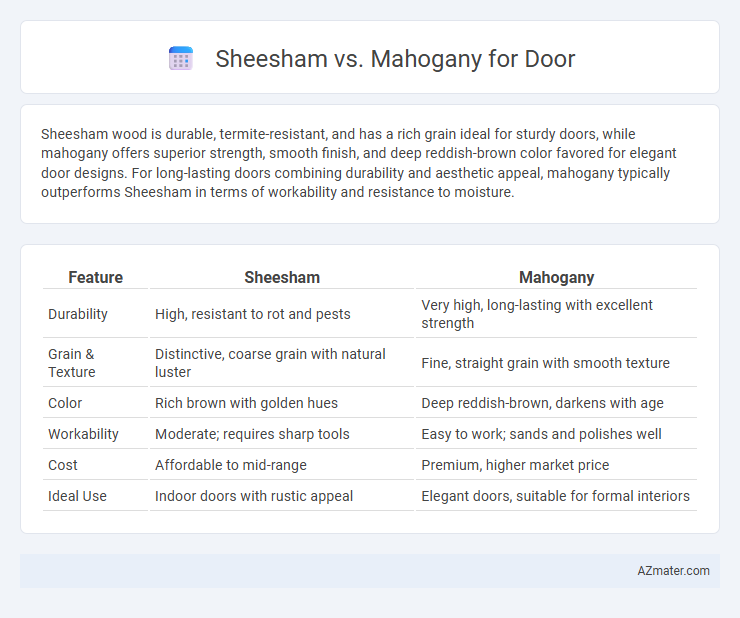Sheesham wood is durable, termite-resistant, and has a rich grain ideal for sturdy doors, while mahogany offers superior strength, smooth finish, and deep reddish-brown color favored for elegant door designs. For long-lasting doors combining durability and aesthetic appeal, mahogany typically outperforms Sheesham in terms of workability and resistance to moisture.
Table of Comparison
| Feature | Sheesham | Mahogany |
|---|---|---|
| Durability | High, resistant to rot and pests | Very high, long-lasting with excellent strength |
| Grain & Texture | Distinctive, coarse grain with natural luster | Fine, straight grain with smooth texture |
| Color | Rich brown with golden hues | Deep reddish-brown, darkens with age |
| Workability | Moderate; requires sharp tools | Easy to work; sands and polishes well |
| Cost | Affordable to mid-range | Premium, higher market price |
| Ideal Use | Indoor doors with rustic appeal | Elegant doors, suitable for formal interiors |
Introduction to Sheesham and Mahogany Woods
Sheesham wood, also known as Indian Rosewood, is prized for its rich grain patterns, high density, and natural oil content that enhances durability and resistance to decay, making it ideal for doors. Mahogany is a tropical hardwood renowned for its deep reddish-brown color, smooth texture, and excellent stability, offering strength and resistance to warping in door applications. Both woods are favored in high-quality carpentry, but Sheesham excels in intricate detailing while Mahogany is preferred for its uniform finish and classic elegance.
Key Differences Between Sheesham and Mahogany
Sheesham, also known as Indian rosewood, features a dense grain with natural oils that resist termites and moisture, making it ideal for durable doors, while mahogany offers a smoother texture and a rich reddish-brown hue favored for its elegant finish. Sheesham tends to be more affordable and showcases distinctive grain patterns, whereas mahogany is valued for its uniformity and stability, often used in high-end custom doors. The key differences lie in durability, appearance, and cost, where Sheesham excels in robustness and natural resistance, and mahogany stands out for aesthetic appeal and fine finishing.
Durability and Strength Comparison
Sheesham wood, known for its high density and natural resistance to decay, offers excellent durability and strength, making it ideal for sturdy doors that withstand heavy usage and environmental stress. Mahogany, renowned for its hard, dense grain and resistance to warping, provides long-lasting structural integrity and superior impact resistance, ensuring doors maintain their form and function over time. When comparing both, Mahogany typically exhibits slightly greater strength and moisture resistance, while Sheesham excels in hardness and natural pest resistance, influencing the choice based on specific durability needs and environmental conditions.
Appearance and Grain Patterns
Sheesham wood features rich, warm tones with a golden to reddish-brown hue and prominent dark grain patterns, making each door visually unique and striking. Mahogany showcases a smooth, reddish-brown to deep red color with a fine, straight grain that offers a sleek and elegant appearance. The distinct grain intricacies of Sheesham provide a rustic charm, while Mahogany's consistent grain pattern lends a more polished, uniform look ideal for sophisticated door designs.
Resistance to Termites and Decay
Sheesham wood, also known as Indian Rosewood, exhibits high resistance to termites and decay due to its natural oils and dense grain structure, making it a durable choice for doors. Mahogany, prized for its fine grain and rich color, also offers strong resistance to termite attacks and fungal decay, attributed to its natural oils and tight cell structure. Both woods are excellent for door construction, but Sheesham's superior termite resistance gives it a slight edge in longevity in termite-prone environments.
Ease of Maintenance and Care
Sheesham wood offers natural resistance to pests and moisture, making it easier to maintain for door applications with just regular dusting and occasional polishing. Mahogany requires more attentive care, including periodic sealing and protection from prolonged exposure to moisture to prevent warping and preserve its rich color. Both woods benefit from avoiding harsh chemicals, but Sheesham generally demands less intensive upkeep over time.
Cost and Availability
Sheesham wood is generally more affordable and widely available in South Asia, making it a cost-effective choice for door manufacturing. Mahogany, prized for its rich color and durability, tends to be more expensive and less readily available due to its slower growth and restricted harvesting. Choosing between the two often depends on budget constraints and regional access to quality wood supplies.
Suitability for Doors in Various Climates
Sheesham wood, known for its natural oils, offers excellent resistance to moisture and termite damage, making it suitable for doors in humid and tropical climates. Mahogany, prized for its dense grain and dimensional stability, performs well in both dry and moderately wet environments, resisting warping and swelling effectively. Choosing between Sheesham and Mahogany depends on local climate conditions, with Sheesham favored in wetter areas and Mahogany ideal for regions with fluctuating humidity levels.
Environmental Impact and Sustainability
Sheesham wood, known for its durability and fast growth, is considered more sustainable than mahogany, which often faces overharvesting and illegal logging concerns due to slower growth rates. Sheesham plantations are typically managed with responsible forestry practices, minimizing deforestation and promoting carbon sequestration. In contrast, mahogany's extraction can contribute to habitat loss and reduced biodiversity, making sheesham a more environmentally friendly choice for door materials.
Final Verdict: Which Wood is Best for Doors?
Sheesham, known for its durability, rich grain patterns, and resistance to termite attacks, offers excellent strength and a warm aesthetic ideal for doors in humid climates. Mahogany provides superior stability, a smooth finish, and natural resistance to decay, making it a premium choice for luxury doors with a high-end appearance. For the best door material, Mahogany excels in long-term performance and elegance, while Sheesham is a cost-effective and robust alternative with distinctive grain beauty.

Infographic: Sheesham vs Mahogany for Door
 azmater.com
azmater.com